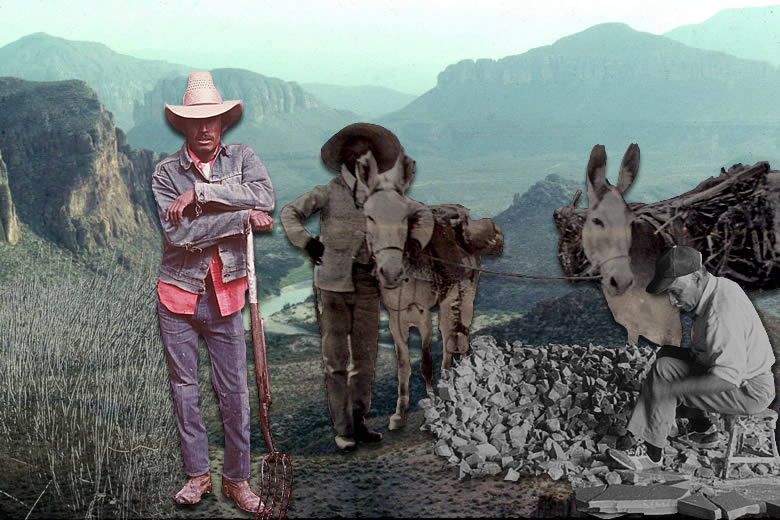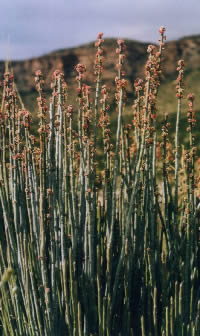
Pencil-like stalks of blooming candelilla
stand in silhouette against the blue desert sky. A source
of high-quality wax used in many common products, the
desert plant is still harvested and processed in traditional
ways involving rigorous labor. Photo by Glenn Evans,
courtesy Texas Memorial Museum, University of Texas
at Austin.
|
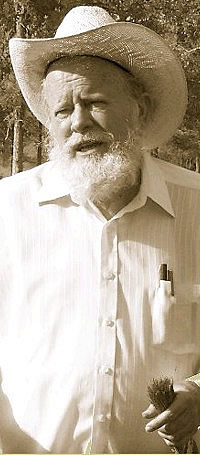
Former State Archeologist and Executive
Director of the Texas Historical Commission Curtis D.
Tunnell. Photo courtesy of the Texas Historical Commission.
|

Cover of the 1981 wax camps report
by Curtis Tunnell for the Texas Historical Commission.
Drawing of candelillero and his heavily laden burro
by Sharon Roos.
|
|
In the 1960s and 1970s, Texas Historical
Commission archeologists surveying the rugged west Texas lands
along the Rio Grande river encountered a fascinating small-scale
industry centered around an inconspicuous wild plant known
as candelilla. While growth
of the stalky, leafless plant is ruled largely by the whims
of nature, the harvesting and extraction of the product—a
high-quality wax—is dependent solely upon the ingenuity
and sweat of Mexican laborers following decades-old traditions.
Then as now, the industry seems almost
shockingly primitive in our crisply modern and mechanized
world, particularly given the value and world-wide usage of
the product. Wax makers (candelilleros)—many of
them working alone in remote areas—cut massive stacks
of the weed by hand, then boil it in jerry-rigged metal vats
to extract the wax. Once cured, the raw wax is stuffed into
huge burlap bags and hauled down dusty trails on the backs
of small burros. Although a few workers have acquired trucks
to expedite the process, paying for gasoline is another matter,
and there are no trucks to equal the nimble burros in areas
where there are no roads.
From these crude origins, the wax is
delivered to buyers, refined in factories, and ultimately
distributed into an international market where it will become
a key ingredient in floor wax, cosmetics, candles, chewing
gum, and other items. Though unknown to most of us, candelilla
wax has touched all our lives in a small way through products
such as these.
The late Curtis Tunnell, former State Archeologist
of Texas and Executive Director of the Texas Historical Commission,
was a leader of those early survey expeditions along the Rio
Grande. Over a decade's time, he developed a fascination with
the industry and an abiding admiration for the self-reliant
wax makers. His conversations, interviews, and research led
to a remarkable study published by the commission in 1981.
In the following exhibits, we take a look at
the wax makers and their way of life as Tunnell observed and
wrote about them roughly two decades ago. The text of his
report is followed closely throughout. In the Introduction,
we learn how an archeological survey project was transformed
into a much richer, transcultural experience. The History
section tracks the wax-making industry back to the turn of
the century when enterprising businessmen with an eye for
new opportunities moved onto the desert frontier. In "From
Desert Plants to Dollars," a fully illustrated Techniques
section takes the reader step-by-step through the wax-making
process, followed by a look at the resourceful Candelilleros
and their camps—fascinating constructions of desert plant
materials and scavenged metal containers.
Historian and ethnographic researcher JoAnn
Pospisil provides an update on the current
state of the wax-making industry and new perspectives
on traditionally held views about women's roles in the process.
New restrictions and trade agreements such as NAFTA as well
as border closings following the events of Septempber 11,
2001, have necessitated a number of shifts in the way the
workers now operate.
Finally, in Tunnell's
Journey, we look back over the life and career of Curtis
Tunnell through recollections and tributes of some of his
friends and colleagues at the THC.
The exhibits are illustrated by Tunnell's exceptional
black and white photos and the charming drawings by Sharon
Roos of the THC. New photos by Pospisil, Big Bend wildlife
biologist Raymond Skiles, and others bring color and additional
views of the industry, the people, and the ruggedly beautiful
west Texas landscape to the presentation.
The Wax Camps exhibits on Texas Beyond History
were supported by a grant through the Curtis Tunnell Memorial
Award, Friends of the Texas Historical Commission. In
these exhibits, TBH reflects Tunnell's appreciation
for lesser-known, traditional cultures and pushes across political
and geographic boundaries to provide a larger, more-meaningful
context for understanding our state's rich cultural heritage.
|
|
In a small way, candelilla wax has touched all our
lives, though unknown to most of us, through a variety
of products.
|
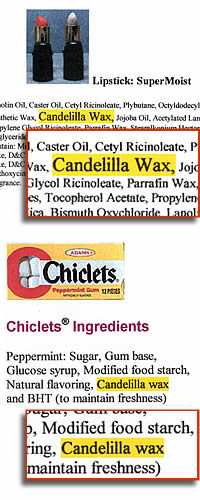
Cosmetics and gum are just two of
the common products made with candelilla wax.
Click images to enlarge
|

The often harsh landscape of the
Chihuahuan desert can be transformed into a scene of
breathtaking beauty after a rain. Photo by Susan Dial.
|
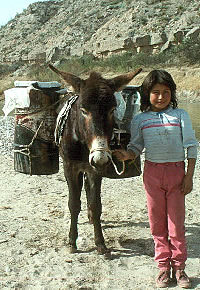
A young girl brings water from the
Rio Grande to the riverbank village of La Caldera. New
photos such as this, contributed by Big Bend wildlife
biologist Raymond Skiles, add color and new perspectives
to Tunnell's original 1981 report.
|
|
